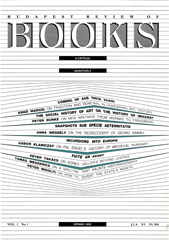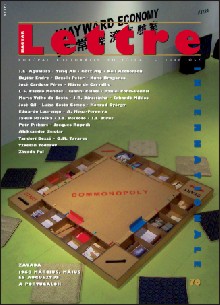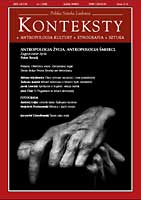
We kindly inform you that, as long as the subject affiliation of our 300.000+ articles is in progress, you might get unsufficient or no results on your third level or second level search. In this case, please broaden your search criteria.


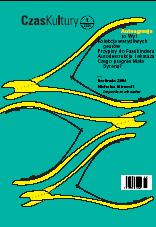
The vicious circle of consumerism is very cleverly structured. It does not leave any room for reflection concerning death. This final perspective in life is skilfully negated in order for the consumer to enjoy short-term happiness skilfully enhanced by the power of advertising and television. The main character of David Fincher’s Fight Club is a satisfied yuppie whose main goal in life seems to be buying furniture. However, his growing sleeplessness becomes a turning point in his well-organised and impassive existence. Jack (played by Edward Norton) who has always been impeccably dressed suddenly stops caring for his attire, work and furniture which until recently provided him with almost sexual excitement. By participating in support group meetings for terminally ill people he can once again get some sleep and death stops being a taboo. Fighting in an amateurs’ club makes him feel his own finiteness. The pain of his sore and bleeding body makes it finally possible for Jack to surpass the hermetic mode of consumption. In the fight club Jack sheds his skin. His own warm blood makes him aware that he has entered a new phase in life and that he has attained a new liberated identity. But Jack’s self-destruction finally reveals its real face. It turns out that his sleeplessness was a symptom of mental disease. His split identity significantly changes the perception of the film. His friend (played by Brad Pitt) who had set up the fight club and its strict rule is suddenly seen in a different light. What seemed real turns out to be something which is going on in the feverish mind of the main character, a mind that cannot stop enjoying auto-aggression and this leads to a dangerous culmination.
More...
Justyna Kowalska — Sztuka pod sztuką a może sztuka spod sztuki / Piotr C. Kowalski, „INNI i Piotr C. Kowalski”: Galeria Biała, Lublin 24.10.–21.11.2003; Galeria ON, Poznań 8.01.–16.01.2004
More...
Marek Wasilewski — Japonki 2050 / Miwa Yanagi, „Deutsche Bank Collection”, Deutsche Guggenheim, Berlin 31.01.–28.03.2004
More...
Can the deep desire of being close to God be associated with physical pain? The intriguing history of Christianity seems to provide a positive answer to this question. In late medieval and early modern times (12th-14th century) both male and female mystics experienced direct contact with the Creator by means of inflicting strong corporal pain upon themselves. Maciej Michalski notices that contemporary literature declared that only an ecstatic state resulting form torturing one’s body could lead to observing God and talking to Him. It is interesting that this highly approved mystical dimension was encountered by simple women. The patriarchal Church had to somehow deal with the fact that it was not the theologically and philosophically educated men but the lowly women who were granted with this celestial honour. The female mystics put their bodies to tests which ordinary mortals could not endure. This included whipping, fasting, sleeplessness and diseases, all aimed at following the martyrdom of Jesus Christ. For them their suffering did not entail the then popular duality between the necessity of depreciating the body and elevating the soul. They perceived it as a beautiful experience of unexpressed happiness with God Himself. Today the behaviour of the female mystics is seen as self-destructive and would definitely require psychological and psychiatric intervention. But such masochistic actions escape the notions of modern times which perceive them as completely inappropriate. In those days these women were regarded with great esteem. They ceased to be ordinary women subjected to the patriarchal social order. Instead they obtained an aura for which they were revered and which gave them a strong position in the contemporary society.
More...
Establishing one’s own unique reality seems a sensible solution to the limitations imposed by the modern world. Feeling lost due to the prevailing social order which makes people act out rigid roles in life is not an abstract concept. Rainer Werner Fassbinder’s films provide viewers with an opportunity to become aware of the almost inherent necessity of creating one’s own existence. In interviews the director himself declared that in fact he was making one and the same film all the time since they all focused around the same existential questions which always remained unanswered. Querelle, 1982, which was strongly criticised, touches the key issue of searching for one’s identity lost in mouldy social stereotypes. The desire for unity is to be fulfilled by love (homosexual love and incest). The relationship between the main character and his brother, however, becomes sado-masochistic. Violence and pleasure are equal elements of their relationship which breaks all social rules. The motive of sacrifice is continuously combined with the motive of rape (René Girard). The beautiful idea of attaining a state of being identical to oneself through another person is brutally wounded by reality, similarly to the way in which the passionate lovers “give birth to the obscenity of their relationship” (Roland Barthes). Trying to achieve happiness means exceeding the limits which have been determined by society. Existence becomes a continuous transgression (Michel Foucault). Hidden desires, dreams and fantasises overcome the hitherto darkness and this is what Fassbinder’s works seem to talk about.
More...
Bartosz Kałużny — Przechodząc koło grafik / „Od Picassa do Warhola – Grafiki mistrzów 1964–2003”, kolekcja nowojorskiej Galerii Marlborough: CSW Zamek Ujazdowski, Warszawa 24.11.–26.12.2003; Muzeum Narodowe w Poznaniu, 6.01.–25.01.2004
More...
Joanna Bator’s short story Bydlądynka deals with the ancient problem of male and female relationships. The main character is a dyed blonde with big breasts who wears underwear with a leopard pattern for special occasions and who overindulges in food and buying new clothes. Her existence focuses around dating a musician who is frustrated and unappreciated by critics. Waiting for his phone call fills the emptiness of her spare time. The naivety of the main character makes her ignore the aggressive behaviour of the egocentric artist. Although he causes her physical and emotional trauma she is persistent in being charmed by his artistic “nonchalance”. Her way to overcome the tension resulting from the relationship is consuming the contents of her refrigerator. One of the unfulfilled expectations that her life concentrates on becomes the turning point of the story. This is the prospect of spending Christmas Eve together and the hope for a real declaration of commitment. The intentional exaggeration of the main character’s image by the author reveals the truth about women’s susceptibility to masochism. The literary fiction depicts the actual threat of toxic relationships, being addicted to a man and losing the sense of one’s own “self”.
More...
The masochistic body art of the 1970’s was deeply set in a social and political context. The artists felt responsible for their performances which were often shocking and misunderstood. These were conducted against the war in Vietnam as well as gender and racial discrimination. It was in this decade that the painful poetics of Gina Pane’s works became most apparent. Paweł Leszkowicz attempts to reveal the layers of meaning in the artist’s works which have been covered by a tendency to make art universal. The series of photographs, Escalade non-anesthésiée (Climbing without Anaesthetics), 1971, in which the artist climbs barefoot on the sharp edges of a metal grating and the Azione Sentimentale (Sentimental Action), 1973, in which rose thorns are stuck into the artist’s forearm and a razorblade cuts her hand are usually perceived as a protest against society which is indifferent to the suffering of the individual. Paweł Leszkowicz, however, draws attention to a more intimate dimension, i.e. Gina Pane’s homosexuality. Through her suffering the artist “sacrificed herself on the altar of a homophobic civilisation” in order to find empathy in viewers who had so far been indifferent or even hostile. The clearly depicted wounds were a symbol of “external aggression” which the artist wanted to confront. The artistic masochism of Gina Pane “is full of religious references”. Similarly to Christ suffering on the cross for his faith the artist wounds her body for the sake of her own homosexual identity. It is not surprising that once she completed her bloody and difficult to endure performances she became interested in sculpture and photography based on the iconography of St. Francis, St. Laurence and St. Sebastian (Partitions). The message expressed by the cry of the female body became fuller set against the martyrdom of these saints.
More...
Agata Jakubowska talks to Anna Baumgart and Joanna Turowicz: Collection of Embarrassing Gestures. The Collection of Embarrassing Gestures exhibition held at Zachęta Gallery in Warsaw from 19 April to 16 May 2004 included a viewing of a stirring video film by Anna Baumgart called Ecstatics, Hysterics and Other Female Saints. The 10-minute piece contained an exceptionally condensed emotional charge. Self-destructive and hysterical female gestures which until now have not been acknowledged have finally been shown to the public. The participation of the author and Joanna Turowicz, the curator of the exhibition, in the film is a noteworthy fact which proves their immense emotional involvement. Both declare that they are fascinated by the enormous creative potential concealed in female auto-aggression and hysteria. Wounding one’s body and cries of despair constitute a specific performance which is usually played out in private. One scene seems to be particularly moving: a crouching woman produces sounds which at times resemble howling and at times a song of mourning. She is biting her arm and a small child toddles around her. This scene seems to be even more touching than the one in which the depicted character cuts herself with a razorblade. Why do women consciously inflict physical pain upon themselves? Both Anna Baumgart and Joanna Turowicz claim that auto-aggression is a way of acting against social enslavement and a way of expressing the nonverbal. Their body language expresses their existential pain. Maybe this brings back the lost sense of their lives which finally becomes touchable again.
More...
The well-known 19th century fairy tale, The Little Mermaid by Hans Christian Andersen is usually perceived as the story of a mermaid who sacrifices her life for the unrequited love for a prince. Renata Bożek takes a different approach in order to reveal the phenomenon of the mermaid’s femininity. The Little Mermaid feels trapped in the underwater world which deprives her soul of immortality. With passion she visualises the world of people and in order to become one of them she undergoes a painful transformation: losing her tongue and replacing her fish’s tail with legs. She wants a new identity. The unspeakable pain which accompanies every step she makes gives her an awareness of her human existence. In this light the author gives examples of self-destructive behaviour of women who intentionally hurt their bodies in order to feel the lost reality of their own “selves”. This, however, points out the basic difference between the mermaid from the fairytale and the real women who are victims of auto-aggression. The Little Mermaid commits a unique form of suicide which enables achieving immortality and her desired spiritual freedom, whereas the women presented by the author perform self-destructive actions in order to achieve harmony between the physical body and the “self”. At the same time it turns out that the psychophysical balance is often distorted by the patriarchal rules which make the world perceive women in terms of their physical attractiveness. By wounding their bodies women strive at regaining control of their lives and exceeding today’s standards. The Little Mermaid may, of course, be interpreted in a traditional way. The Mermaid falls in love with a prince whom she saves from drowning in the sea and with whom she wishes to spend the rest of her life.
More...
The “rat race” of contemporary times inflicts an overwhelming speed in which people live out their lives. For some this turns out to be difficult to bear. The promoted model of a man/woman of success who performs well in a competitive atmosphere, who is resistant to stress and has won professional acclaim may be devastating for some people and lead to self-destructive behaviour culminating in suicide. Anna Suchańska analyses this still unexplained phenomenon of taking one’s own life. Undoubtedly, the suicidal person’s self-image and perception of the world is completely distorted: their perspective becomes narrowed to their own suffering, solitude and hopelessness while their self-preservation instinct is painfully suspended. Obviously, help from those who surround such people would remedy these situations, but suicidal symptoms often remain unnoticed and even underestimated. Another form of self-destructive behaviour observed today is the fashion for taking extreme risks concerning one’s own health and even life. The author stresses that the border between the normal and the pathological is becoming dangerously vague. An example of this is forcing one’s body to meet the modern standards of beauty. From the psychologist’s point of view, the source of such attitudes may be found in childhood complexes: lack of self-esteem pushes people to actions which result in attracting the approving glances of others. This leads the author to the question: how can we solve the problem of self-destruction? The answer does not require tremendous insight: the problem could be solved by deep and real bonds with other people.
More...
The truth that art had been a result of unlimited desire of indulgence resulted in understanding, experiencing and comprehending all kinds of art product. Work of arts and concepts that characterized them showed variety with the events emerged in the course of time and with the cultures from where they appeared. When examining any work of art pertaining to any period, it is required to examine society and people of the same period and time slice from all aspects. Clues that are found from the culture of society created by artist in his/her work of art can determine axis of capability of answering the questions wondered about within the interpretation process of work. To explain and understand any work of art in respect of its subject treated in the light of historical and cultural knowledge is a requirement, because in these works, there is an agreed meaning that is deliberately and intentionally put by artist. For assessment and experience of the work of arts, first of all, there must be an agreed meaning and it must be analyzed. In this study, study of criticism on work of art, backgrounds of aesthetic perception and collective structure between time and place have been examined with the example of David and Goliath.
More...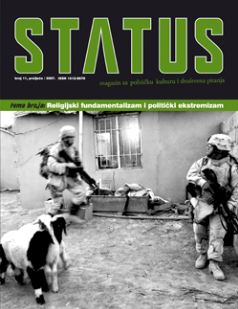
Ispravno tumačenje srednjovjekovnog konteksta ikonografije fethijskog inventara omogućilo bi ravnotežu među njenim različitim potencijalnim nasljednicima. Da li pravo na njeno nasljedstvo može ostvariti muzeologija, okončavajući njen viševjekovni duhovni kontinuitet ili džamija i vjerska zajednica muslimana? Ovo pitanje se u različitim krugovima u zadnje vrijeme sve više postavlja a odgovori ili su nestručni, ili tendenciozni ili subjektivni. ... Muzeologija kao agnostička disciplina do krajnjih granica razvija kult vanjskog zapostavljajući ono skriveno i suštinsko.
More...

